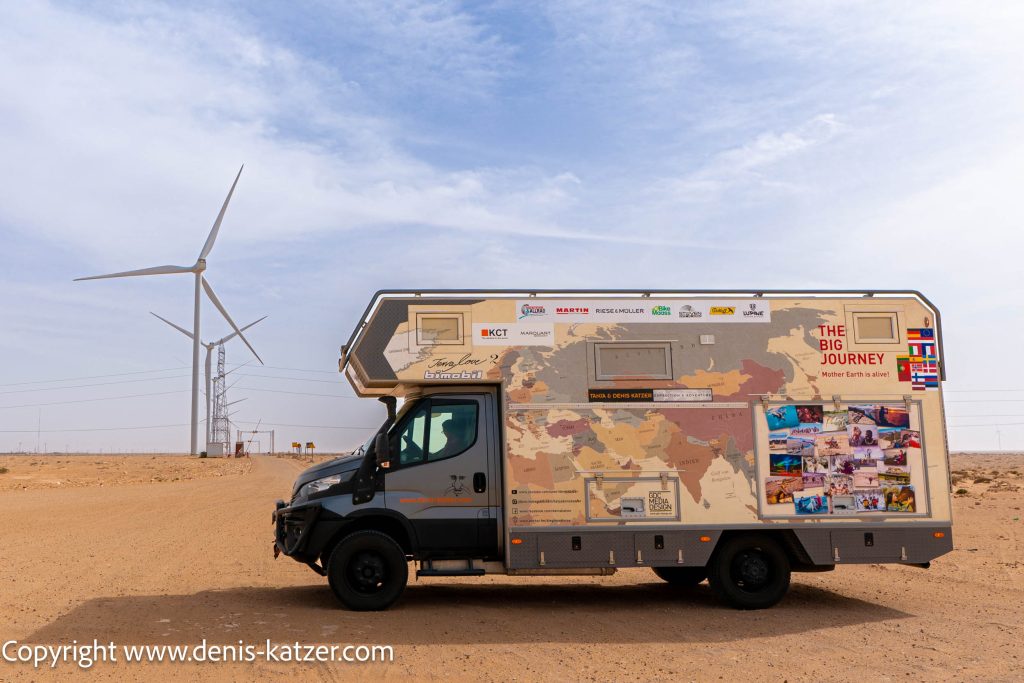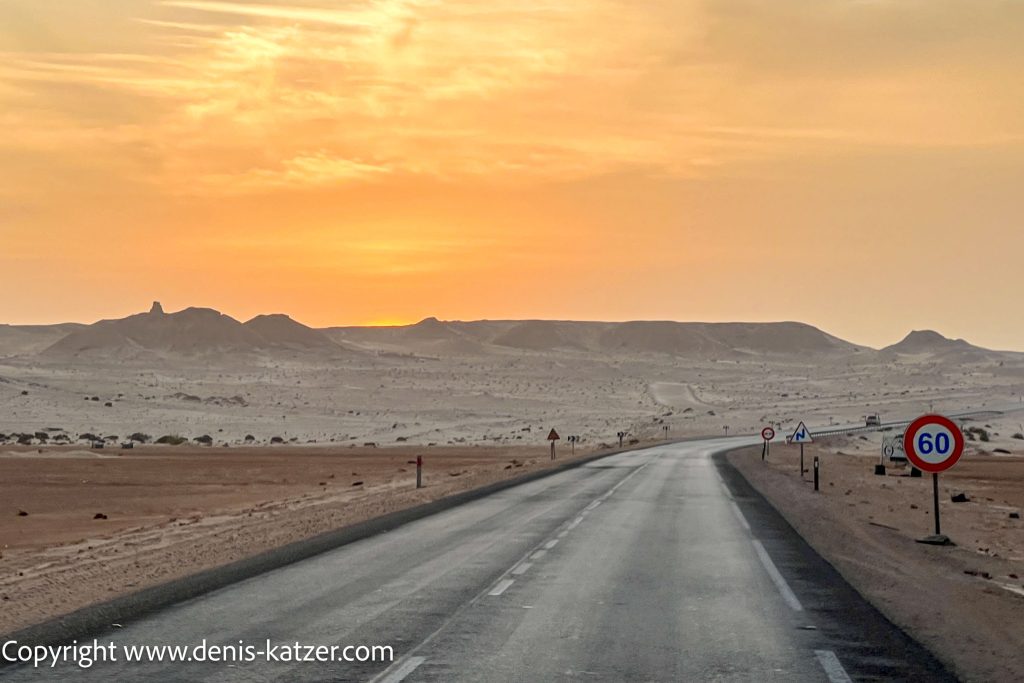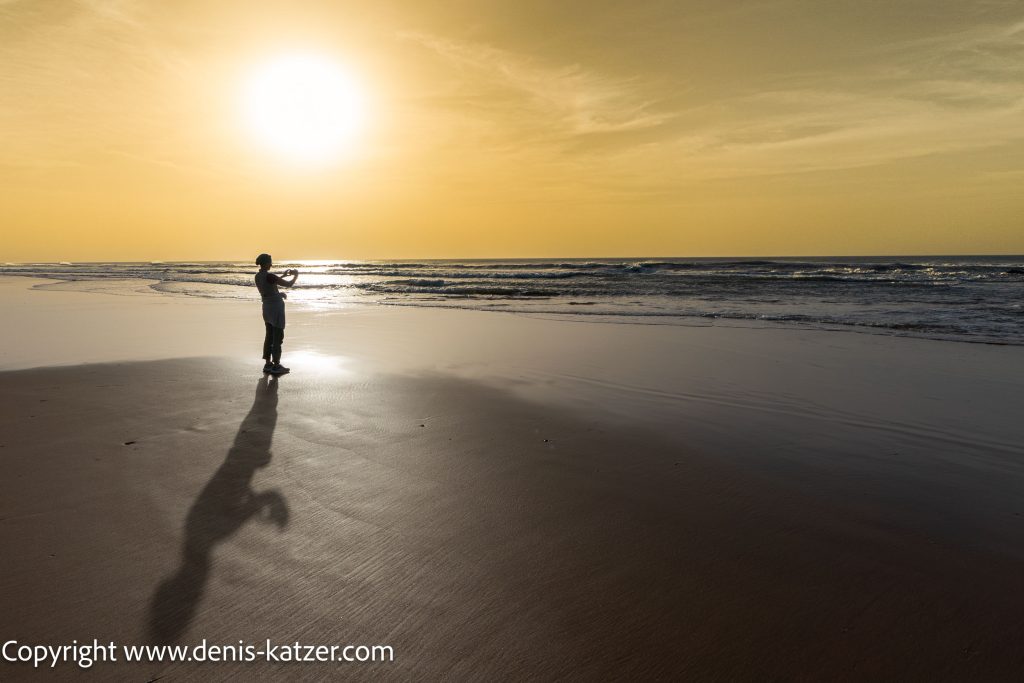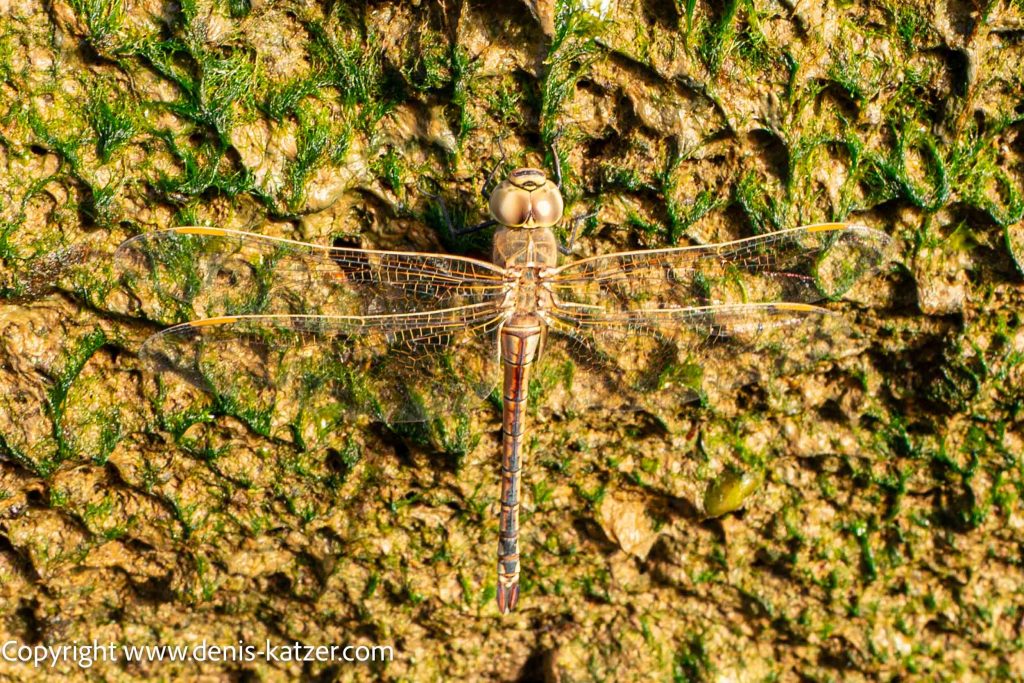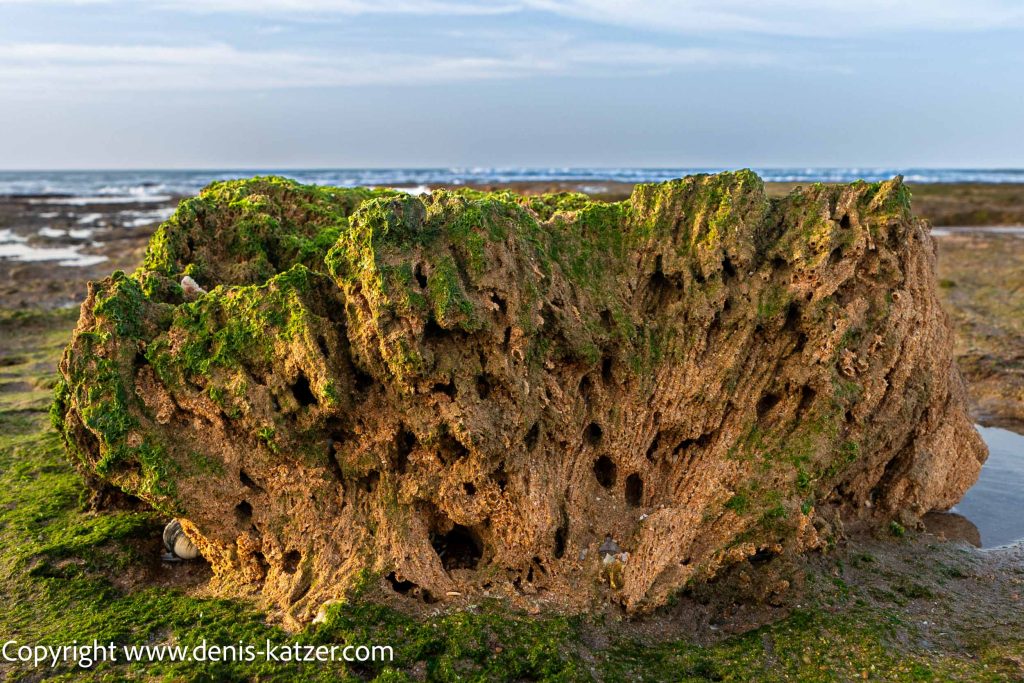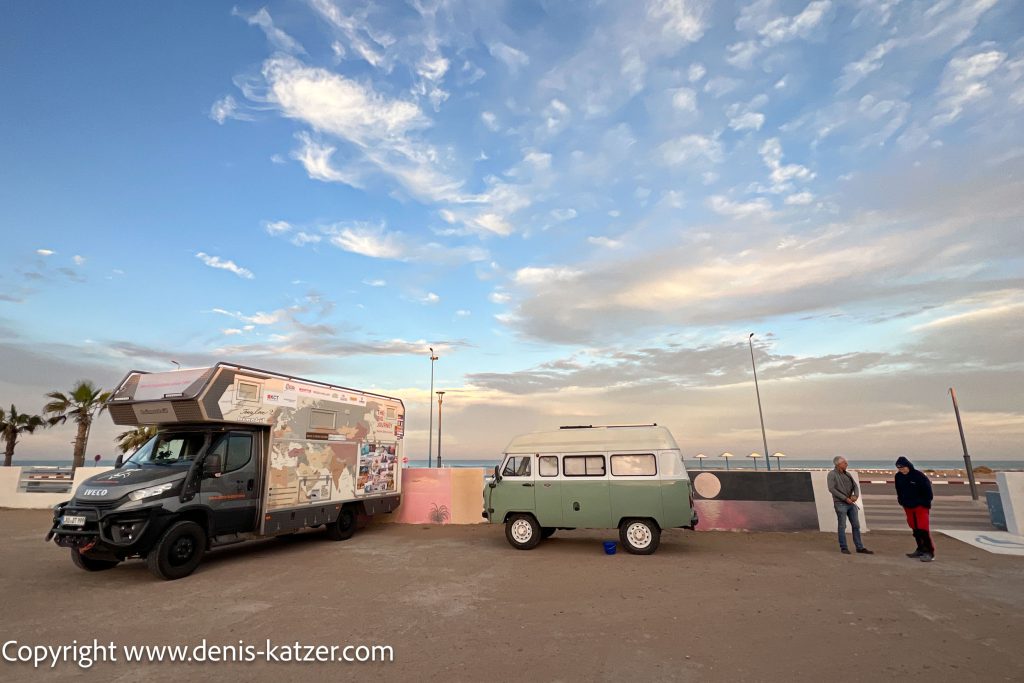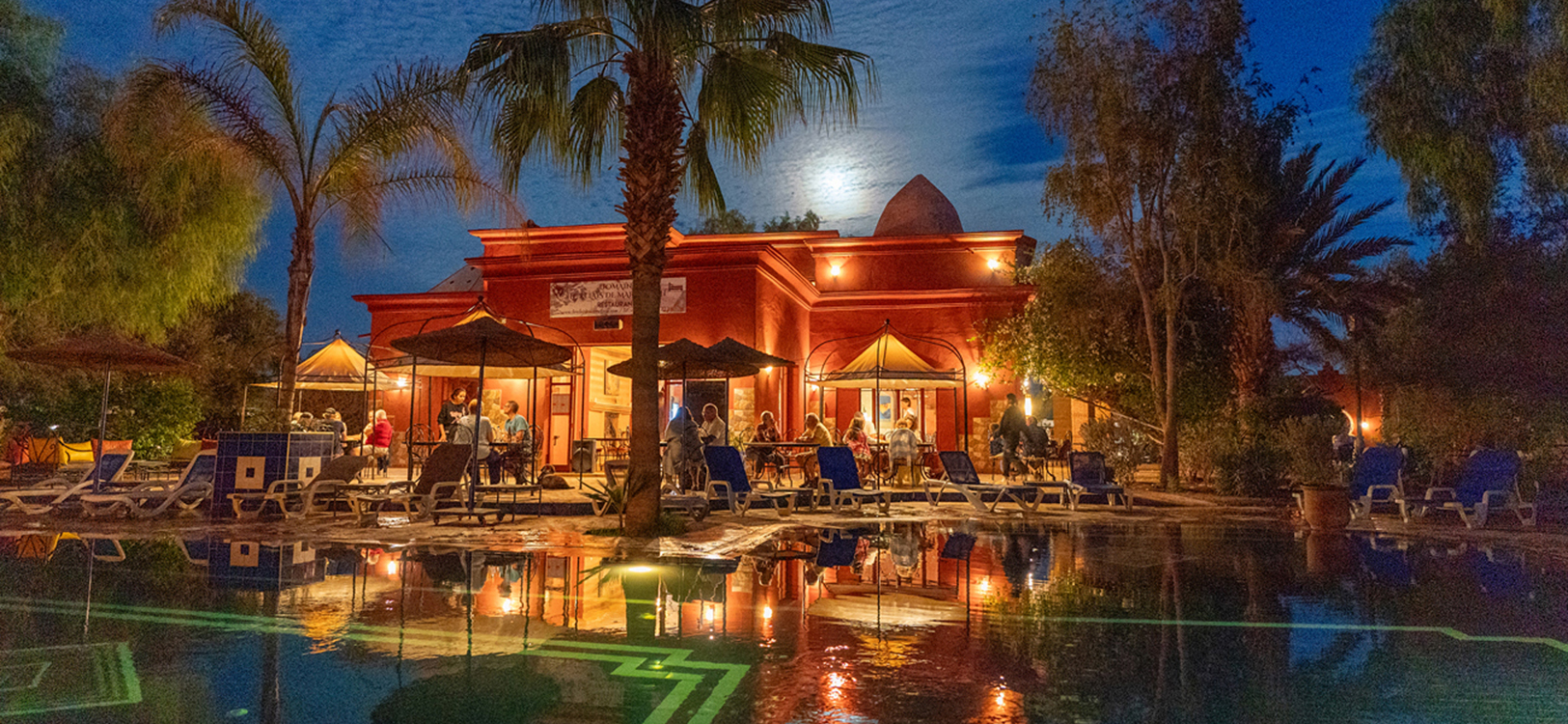
Through the Sahara in a motorhome
N 27°11'31.5" W 013°23'13.6"
Day: 01/23/2024
Day: 417
Camp 74
Country: Morocco
Place: El Ajun
Latitude N: 27°11’31.5″
Longitude W: 013°23’13.6″
Daily kilometers: 586 km
Total kilometers: 11,143 km
Height: 5 meters
Temperature day max: 24°
Night temperature: 15 °
Departure: 8:50 am
Arrival: 18:30
Travel time: 9:40 hrs.
The first rays of sunlight penetrate the morning air, which is filled with fine Saharan sand. I turn the ignition key to the right and the engine of our Terra Love comes to life with a rich hum. Tanja, as always when we leave a place, walks once around the Terra and signals with a thumbs-up that all hatches, flaps and windows are closed. “Let’s go!” I exclaim in a good mood, looking forward to the upcoming 600-kilometre stage through the Western Sahara.
“How beautiful,” says Tanja as we drive towards the golden, delicate ball of sunlight, which looks vulnerable at this early hour. Watching the sunrise in the desert is an unforgettable experience full of beauty and tranquillity. The silence and solitude allow us to feel at one with nature and the universe. As the sun slowly climbs the horizon, we experience the fascinating changes in light that bathe the sky and landscape in vibrant colors. For us, this is a moment of freedom and adventure that fills our hearts with a sense of new beginnings.
We follow the asphalt strip that lies like a dark band over the light desert sand and makes it possible for us to cross the Sahara, also known as the desert of deserts, in the first place.
“There’s a petrol station there,” says Tanja, pointing to a few buildings that seem to have been thrown there at random. “Great,” I reply, putting the blinker on. With our 200-liter tank and the two additional 20-liter reserve canisters on the rear wall of the Terra Love, we have a range of around 1600 kilometers. Thanks to this equipment, we didn’t have to refuel during our trip through Mauritania, which was very convenient for us, as diesel is more expensive there and not always of good quality. But now the tanks are empty, so we head for the filling station just after the Daklah lagoon.
After our visas for Morocco expired two months ago, we decided to travel to Mauritania to spend some time there. We planned to return to Morocco to tour the south of the country and make improvements to our Terra Love before traveling the same route back to Mauritania to continue our journey to South Africa. That is the reason why we are now heading north again.
We continue our journey on the N1, while the surrounding desert landscape hardly changes. Tanja and I regularly take turns at the wheel to navigate safely through the endless sea of sand and make good progress despite strong winds and sand drifts. Our mood is good, and although we already know the route, it was more exciting when we crossed the Western Sahara towards Mauritania for the first time. At that time, everything was still new and unknown to us. We were even unsure whether we should drive through the Western Sahara to Mauritania, as this region has been the subject of a political conflict since 1975, which may have claimed tens of thousands of lives so far. The exact number is not known. However, it is currently considered safe for travelers and tourists to drive through this section of the desert, at least according to our experience and personal opinion. Nevertheless, it is important to keep an eye on the political situation before traveling.
We are repeatedly surprised by sandstorms on the 1,200-kilometer desert route. The wind is so strong that Tanja or I, depending on who is behind the wheel, have to hold the steering wheel firmly to prevent our Terra Love from being pushed off the road. The sandstorms of the Sahara, also known as “Harmattan”, are a fascinating meteorological phenomenon that occurs regularly in the region of North Africa. These storms are caused by dry, dusty winds blowing westwards from the Sahara desert region. They transport huge quantities of fine sand and dust, often over long distances. The scale of these storms can be immense and even cross the Atlantic. The dust carried along can severely impair visibility and lead to extreme weather conditions. The sandstorms of the Sahara not only have local effects, but also influence the global climate. The dust transported by the storms can enter the atmosphere and influence cloud formation and the reflection of sunlight, which in turn can have an impact on the climate in various regions.
In the last few weeks I have been suffering from a gastrointestinal illness and an eye infection. Both are due to the fine sand that swirls around in the air. When the sand is brushed against the ground, it picks up countless bacteria which, when inhaled, can enter the respiratory tract and cause illness.
As we drive through this hostile region, the camel caravans that once traveled through the Sahara come to mind. They formed the heart of a fascinating trade network that transported goods between the regions of North Africa and beyond. Hundreds of camels, led by experienced caravan guides, crossed the endless sand dunes to transport goods such as gold, salt and spices. These epic journeys were not only logistical feats, but also cultural encounters that carried ideas, languages and religions from one end of the Sahara to the other. The caravans brave the relentless challenges of the desert – from heat and sandstorms to the threat of thirst and robberies. The stories of the camel caravans are full of adventure, courage and discovery and have left a deep historical and cultural impact.
“Wow!” I exclaim as huge wind turbines rise up to the left and right of the sand-covered asphalt strip. Like giant fighting monsters, they swing their gigantic rotors through the fine dust-laden air and emit menacing, whirring noises. Western Sahara has considerable potential for the use of wind energy due to its vast desert landscape and strong, constant winds. This not only represents a clean and renewable source of energy, but also makes a significant contribution to economic development by creating jobs and improving the security of energy supply. The use of wind energy in Western Sahara plays an important role in the fight against climate change and helps to reduce dependence on fossil fuels.
The subsidiary Siemens Gamesa Renewable Energy has supplied 87 wind turbines for the Boujdour wind farm in Western Sahara. This has a total capacity of 301 MW and enables an annual electricity generation of 1,590 GWh. This will reduce emissions by 1,145,000 tons of CO2 per year. This is already the fifth wind farm that Siemens has built in cooperation with the Moroccan government. These wind farms also supply the phosphate mine operated by the Moroccan state in Western Sahara with electricity.
It is 6:30 p.m. when we reach our destination for today’s stage after 586 kilometers and 10 hours of driving. About 24 kilometers before the town of El Aaiun at the Plage de Laayoune, we head for a parking space provided by the municipality for motorhomes. When we stayed here about 2 months ago on our journey towards Mauritania, we were the only campers. Now it is almost full and we are happy to find a place for the night. As soon as we have parked our Terra Love, we set off for a walk along the Plage de Laayoune, also known as Laayoune beach. The sun slowly sinks towards the horizon as we stroll hand in hand across the golden sand and enjoy the calming sound of the waves. It’s a peaceful evening and the sandstorm that made driving difficult during the day has subsided. The beach is deserted, which gives us a feeling of intimacy and freedom.
The beach at Laayoune stretches along the Atlantic coast and impresses with its golden sand and clear blue water. Like many beaches along the west coast, it is also suitable for water sports such as surfing and kitesurfing when conditions are favorable. It is a beautiful, secluded beach that even the locals like to use for sunbathing and swimming. We review the day, talk about the rest of our journey, listen to the gentle sound of the waves and take a few photos to capture these special moments. As darkness slowly descends over the sea and the sandy wind from the desert picks up again, we slowly make our way back to our expedition vehicle.
Here is the link to the video:
